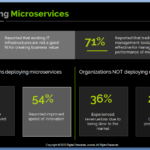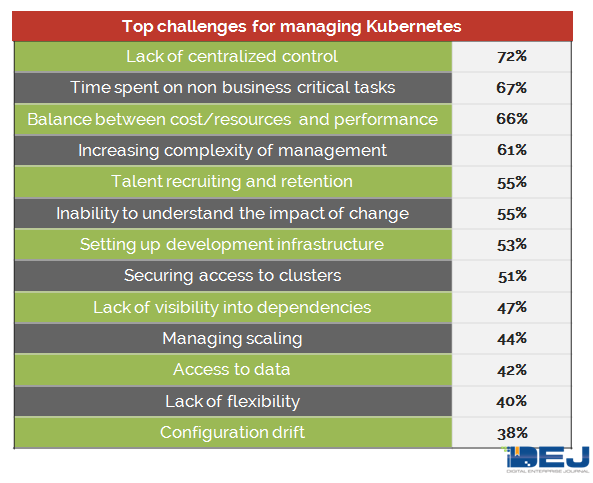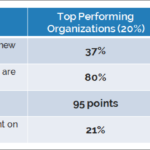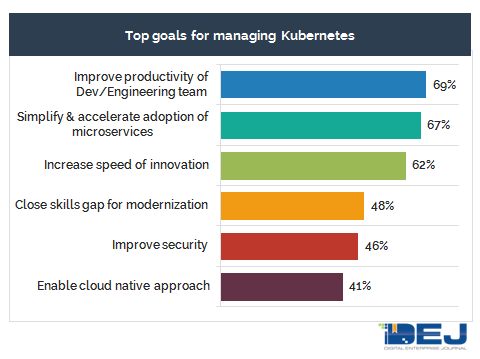Digital Enterprise Journal (DEJ) just completed research around managing Kubernetes and the findings will be published in an upcoming study – “The Roadmap to Becoming a Leading Organization in Managing Kubernetes”. The study is based on DEJ’s Maturity Class methodology and includes insights from more than 1,000 organizations. The goal of the study is to help user organizations benchmark their performance and use practices of top performing organizations (TPOs – top 20% of survey participants based on performance) to identify survey data-backed recommendations for improving performance.
This DEJ’s Analyst Note summarizes some of the study’s key findings and provides insight into actions that TPOs are taking in four areas: strategy, process, organization and technology.
Market context
The study shows that organizations are increasingly realizing that they need to modernize their environments in order to stay competitive in the market. The modernization process can be challenging on its own and it becomes even more difficult as many businesses are playing catch up and competing with organizations that are taking a cloud native approach. What both of these groups of organizations have in common is that they are addressing the same or similar sets of challenges when trying to maximize the business value of deploying microservices.
DEJ’s recent study on the state of IT performance revealed that leading organizations are 3.8 times more likely to report orchestration capabilities as a key enabler for innovation, as compared to all others. Kubernetes is an open source orchestration platform for managing containerized services and it is becoming widely deployed. Even though deploying Kubernetes results in a number of benefits, its management is associated with multiple challenges.
Key goals and challenges
DEJ’s study shows that deploying Kubernetes results in a number of operational and business benefits. Leading organizations in managing Kubernetes are able to successfully address the key challenges of modernization, use technology as a competitive advantage and enable their IT staff to have a strong impact on key business outcomes. However, managing Kubernetes is associated with a large number of challenges and a wide range of these points requires a strategic approach for addressing them.
DEJ’s study identified a number of strategies, actions for improving organizational alignment and streamlining processes as well as technology capabilities that TPOs are more likely to be deploying, as compared to all others.
TPOs practices should serve as guidelines for all other organizations to improve their effectiveness in managing Kubernetes.
Strategies of leading organizations
DEJ’s analysis of TPOs practices goes beyond deployments of technology capabilities and the study also identified a set of strategies for managing Kubernetes that TPOs are more likely to be putting into place.
Everything in a business context
DEJ’s upcoming study on Strategies of Leading Organizations in Adopting Observability shows that a perfect storm of business and technology trends is driving organizations to drastically change how they think about technology and go about managing it. Looking at the long list of challenges that the majority of organizations are trying to address naturally brings up the question – “is it worth it?”. The study shows that the clear answer is “yes”, as organizations are experiencing significant business benefits from deploying Kubernetes. However, the study also shows that TPOs are 2.6 times more likely to include Kubernetes management into their general business strategies and they are putting processes into place to ensure that each aspect of executing on their software delivery approaches is done with an eye on impacting key business outcomes.
Organizations reported, on average, a 6.8x improvement in time to market after deploying Kubernetes
Taking a holistic approach is not optional
As the challenges that organizations are reporting span across multiple areas and domains, the study shows that TPOs are nearly 3 times more likely to have dedicated strategies for addressing every area of Kubernetes management. That allows them to be more effective in addressing key challenges, but also better prepared to deal with changes in their external and internal environments.
Balancing act
The need to find the right balance between cost and resource utilization on one side and ensuring optimal performance and creating exceptional user experiences on another is a theme that cuts across each of the study’s areas, from strategy and processes to a variety of different technology enablers. The study shows that TPOs are much more likely to have technology enabled processes in place and, as a result, 84% more likely to reduce cost while maintaining, or even improving application performance.
Maximizing engineering work is key and requires changes to processes
DEJ’s recent study on The Total Business Impact of IT Performance showed that 68% of organizations do not have visibility into how their engineering resources are being used. The same study also revealed a $3.4 million average annual revenue loss due to Engineers not focusing on business critical tasks. This study shows that TPOs are 68% more likely to have defined processes in place for monitoring and measuring the alignment of engineering work with key business goals. Having these types of processes in place also allows organizations to get the most out of their Kubernetes management efforts and focus on capabilities that will enable them to reduce the amount of toil.
Enabling IT Operations
Forty-eight percent of organizations are deploying Kubernetes to close the skills gap for modernization. Additionally, 55% report recruiting and retaining talent as one of the key challenges. The study shows that TPOs are 72% more likely to enable their staff to run microservices without specific expertise in that domain (containers, pipelines, etc.). These organizations are understanding that the war for talent in a world that is ruled by modernization and cloud native technologies is very hard to win. Therefore, they are putting processes and technology in place to enable their IT Operations professionals to be effective in these complex and dynamic environments.
Key themes of TPOs technology capabilities
DEJ’s survey examined hundreds of technology capabilities for managing Kubernetes to identify those that organizations have in place, as well as their purchasing plans for the near future. The study identifies a number of capabilities that TPOs are more likely to be deploying and (for purposes of this Research Note) they can be grouped in a several different categories.
Not all Lifecycle Management platforms are created equal. The study found that TPOs are 66% more likely to be taking a lifecycle approach for managing Kubernetes. However, after diving deeper into the capabilities that are included in these platforms, the study identifies several key functionalities that are making the strongest impact on performance.
Cost/resource-performance optimization. This is reported as one of the key challenges for Kubernetes management. The study found that TPOs are saving, on average, $1.24 million annually by deploying capabilities for improving visibility, AI and ML enabled optimization functionalities, autodiscovery, prioritization, etc.
Automation. This is an essential capability of TPOs and it is enabling a number of core functionalities that are addressing the majority of management challenges. Some automation functionalities that TPOs are more likely to be deploying include the ability to automatically distribute workloads across different areas, provisioning automation, automatically generating pull requests, etc.
Unified view and control. TPOs are more likely to centralize their visibility and control across multiple clusters, different types of infrastructures, user policies, security, compliance, etc.
Optimization. The study shows that TPOs are more likely to be deploying capabilities for continuous optimization of resources, performance and cost. These organizations are also more likely to be deploying capabilities for automatically optimizing container images and compute infrastructure.
Visibility, analytics and context. This area is one of the biggest difference makers, as all organizations are dealing with massive amounts of data. The study shows that TPOs are more likely to be deploying predictive and real-time analytics and leveraging capabilities that allow them to put data in an actionable context at scale.
GitOps. The study shows a 59% increase in the number of organizations that are leveraging GitOps over the last 12 months. TPOs are 2.4 times more likely to be deploying Kubernetes management platforms that include GitOps service and 65% more likely to be automating Kubernetes management with GitOps.
Data services and storage. This is also one of the areas where TPOs are taking a much more mature approach by deploying capabilities such as storage solutions with integrated capabilities for Kubernetes management and a set of functionalities for dealing with data gravity.
Security and compliance. This is another area where strategies of TPOs centered around taking a holistic approach become very important. The study shows that TPOs are more likely to be deploying capabilities such as securing access to kubectl and controlling access to both Developers and management systems to Kubernetes infrastructure.
Scalability. The study shows that TPOs are more likely to be deploying capabilities such as intelligence around selecting resources for scale-up events, autoscaling, simplifying scaling policies, etc.
Some of the other technology areas where TPOs are deploying more advanced capabilities and putting more emphasis on include:
- Leveraging open source technologies
- Using time to value as a selection criteria
- Support and management of cloud native technologies
- Capabilities for real-time management
- Collaboration capabilities
- Capabilities for proactive and predictive management
- Migration and mobility capabilities
- Capabilities for back-up and recovery
Summary
The study shows that managing Kubernetes is a completely new game for many organizations that is associated with a diverse set of challenges, growing complexity and increasing expectations for performance. In general, managing Kubernetes is not easy and it requires a holistic approach enabled by different types of capabilities.
However, the study shows that deploying and managing Kubernetes is well worth it. Organizations in DEJ’s recent study reported, on average, a 6.8x improvement in time to market after deploying Kubernetes. Additionally, this study shows that TPOs are spending 61% less on cloud services, as compared to all others.
Following approaches of leading organizations in managing Kubernetes impacts each of the key business outcomes. Taking a holistic, business-centric approach for dealing with the complexity of Kubernetes operations is one of the key prerequisites for using technology as a source of competitive advantage.
















